Casuarina
| Casuarina | |
|---|---|
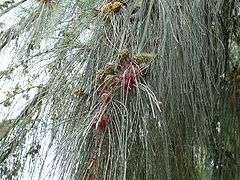 | |
| Casuarina equisetifolia, showing red female flowers and mature cones | |
| Scientific classification | |
| Kingdom: | Plantae |
| (unranked): | Angiosperms |
| (unranked): | Eudicots |
| (unranked): | Rosids |
| Order: | Fagales |
| Family: | Casuarinaceae |
| Genus: | Casuarina L. |
| Species | |
|
See text | |
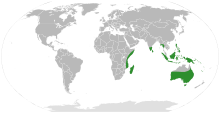 | |
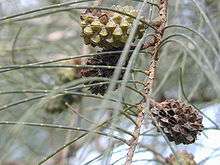
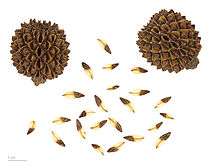
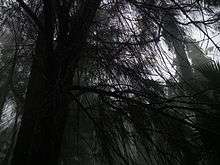
Casuarina is a genus of 17 tree species in the family Casuarinaceae, native to Australia, the Indian Subcontinent, southeast Asia, and islands of the western Pacific Ocean. It was once treated as the sole genus in the family, but has been split into three genera (see Casuarinaceae).[1][2]
They are evergreen shrubs and trees growing to 35 m tall. The foliage consists of slender, much-branched green to grey-green twigs bearing minute scale-leaves in whorls of 5–20. The apetalous flowers are produced in small catkin-like inflorescences. Most species are dioecious, but a few are monoecious. The fruit is a woody, oval structure superficially resembling a conifer cone, made up of numerous carpels, each containing a single seed with a small wing.[1][3] The generic name is derived from the Malay word for the cassowary, kasuari, alluding to the similarities between the bird's feathers and the plant's foliage,[4] though the tree is called rhu in current standard Malay.
Casuarina species are a food source of the larvae of hepialid moths; members of the genus Aenetus, including A. lewinii and A. splendens, burrow horizontally into the trunk then vertically down. Endoclita malabaricus also feeds on Casuarina. The noctuid turnip moth is also recorded feeding on Casuarina.
Pedunculagin, casuarictin, strictinin, casuarinin and casuariin are ellagitannins found in the species within the genus.[5]
Selected species
- Casuarina cristata Miq. (Northeastern Australia: Queensland, New South Wales).
- Casuarina cunninghamiana Miq. – River Sheoak (Northern and eastern Australia: Northern Territory to New South Wales)
- Casuarina equisetifolia L. – Australian Pine, Beach Sheoak, Common Ironwood (Northern Australia, southeastern Asia, doubtfully native to Madagascar), ঝাউ in বাংলা (Bengali), ಗಾಳಿ ಮರ (GaaLi mara) in Kannada.
- Casuarina glauca Sieber ex Spreng. Gray Sheoak, Longleaf Ironwood, Saltmarsh Ironwood, Swamp Oak (New South Wales)
- Casuarina grandis L.A.S.Johnson (New Guinea)
- Casuarina junghuhniana Miq. (Indonesia)
- Casuarina obesa Miq. (Southern Australia: southwestern Western Australia, New South Wales [one site, now extinct], Victoria)
- Casuarina oligodon L.A.S.Johnson (New Guinea)
- Casuarina pauper F.Muell. ex L.A.S.Johnson (interior Australia)
Formerly placed here
- Allocasuarina acuaria (F. Muell.) L.A.S.Johnson (as C. acuaria F.Muell.)
- Allocasuarina acutivalvis (F. Muell.) L.A.S.Johnson (as C. acutivalvis F.Muell.)
- Allocasuarina campestris (Diels) L.A.S.Johnson (as C. campestris Diels)
- Allocasuarina corniculata (F.Muell.) L.A.S.Johnson (as C. corniculata F.Muell.)
- Allocasuarina decussata (Benth.) L.A.S.Johnson (as C. decussata Benth.)
- Allocasuarina distyla (Vent.) L.A.S.Johnson (as C. distyla Vent.)
- Allocasuarina drummondiana (Miq.) L.A.S.Johnson (as C. drummondiana Miq.)
- Allocasuarina fibrosa (C.A.Gardner) L.A.S.Johnson (as C. fibrosa C.A.Gardner)
- Allocasuarina fraseriana (Miq.) L.A.S.Johnson (as C. fraseriana Miq.)
- Allocasuarina grevilleoides (Diels) L.A.S.Johnson (as C. grevilleoides Diels)
- Allocasuarina helmsii (Ewart & Gordon) L.A.S.Johnson (as C. helmsii Ewart & Gordon)
- Allocasuarina huegeliana (Miq.) L.A.S.Johnson (as C. huegeliana Miq.)
- Allocasuarina humilis (Otto & A. Dietr.) L.A.S.Johnson (as C. humilis Otto & A.Dietr.)
- Allocasuarina inophloia (F. Muell. & F. M. Bailey) L.A.S.Johnson (as C. inophloia F.Muell. & F.M.Bailey)
- Allocasuarina lehmanniana subsp. lehmanniana (as C. baxteriana Miq. or C. lehmanniana Miq.)
- Allocasuarina littoralis (Salisb.) L.A.S.Johnson (as C. littoralis Salisb. or C. suberosa Otto & A.Dietr.)
- Allocasuarina luehmannii (R.T.Baker) L.A.S.Johnson (as C. luehmannii R.T.Baker)
- Allocasuarina muelleriana (Miq.) L.A.S.Johnson (as C. muelleriana Miq.)
- Allocasuarina nana (Sieber ex Spreng.) L.A.S.Johnson (as C. nana Sieber ex Spreng.)
- Allocasuarina paludosa (Sieber ex Spreng.) L.A.S.Johnson (as C. paludosa Sieber ex Spreng.)
- Allocasuarina pusilla (Macklin) L.A.S.Johnson (as C. pusilla Macklin)
- Allocasuarina thuyoides (Miq.) L.A.S.Johnson (as C. thuyoides Miq.)
- Allocasuarina torulosa (Aiton) L.A.S.Johnson (as C. tenuissima Sieber ex Spreng. or C. torulosa Aiton)
- Allocasuarina trichodon (Miq.) L.A.S.Johnson (as C. trichodon Miq.)
- Allocasuarina verticillata (Lam.) L.A.S.Johnson (as C. quadrivalvis Labill., C. stricta Aiton or C. verticillata Lam.)
- Gymnostoma deplancheanum (Miq.) L.A.S.Johnson (as C. deplancheana Miq.)
- Gymnostoma nodiflorum (Thunb.) L.A.S.Johnson (as C. angulata J.Poiss. or C. nodiflora Thunb.)
- Gymnostoma papuanum (S. Moore) L.A.S.Johnson (as C. papuana S.Moore)
- Gymnostoma rumphianum (Miq.) L.A.S.Johnson (as C. rumphiana Miq.)
- Gymnostoma sumatranum (Jungh. ex de Vriese) L.A.S.Johnson (as C. sumatrana Jungh. ex de Vriese)[6]
Cultivation and uses
Commonly known as the she-oak, sheoak, ironwood, or beefwood, casuarinas are commonly grown in tropical and subtropical areas throughout the world. The tree has delicate, slender terminal branches, and leaves that are no more than scales, making the tree look more like a wispy conifer. The plants are very tolerant of windswept locations, and are widely planted as windbreaks, although usually not in agricultural situations.
C. equisetifolia is a common tropical seashore tree known as Common Ironwood, Beefwood, Bull-oak, or Whistling-pine, and is often planted as a windbreak. The wood of this tree is used commercially for shingles or fencing, and is said to make excellent, hot burning firewood.
C. oligodon has been planted in New Guinea in an ancient (more than 3,000 years) silviculture by highland gardeners practicing an intensive traditional permaculture. The wood of this tree is used for building-timber, furniture and tools, and makes excellent firewood. The tree's root nodules are known to fix nitrogen, and it is traditionally prized for its ability to increase the soil's fertility. Its abundant leaf-fall is high in nitrogen and traditionally prized for mulch.
The resin exuded from some casuarinas is edible and was a food source for Aboriginal people.
Gardeners in Bermuda can appreciate that all parts of the casuarina tree (needles, sawdust, bark, and prepared mulch) can be useful in lowering the soil pH, as Bermuda's topography consists of naturally high pH limestone rock, and perhaps only a foot of red or sandy soil. Lowering soil pH makes the soil more acidic, which can help Bermuda's biodiversity by growing acid-loving plants such as blueberries, blackberries, azaleas, rhododendrons, and such plants that may be seen in similar hardiness zones as Bermuda (USDA 9-11), such as plants found in New Zealand and Florida, which naturally have a lower pH soil than Bermuda.
Invasive species
C. cunninghamiana, C. glauca and C. equisetifolia has become naturalized in several countries, including Argentina, Bermuda, Cuba, China, Egypt, Israel, Iraq, Mauritius, Kenya, Mexico, South Africa, Rio de Janeiro, the Bahamas[8] and the southern United States; in the United States it was introduced in the early 1900s, and is now considered an invasive species.[9][10] The species has nearly quadrupled in southern Florida between 1993 and 2005, where it is known as Australian pine.[11]
C. equisetifolia is widespread in the Hawaiian Islands where it grows both on the seashore in dry, salty, calcareous soils and up in the mountains in high rainfall areas on volcanic soils. It is also an introduced, invasive plant in Bermuda,[12] where it was introduced to replace the Juniperus bermudiana windbreaks killed by juniper blight in the 1940s. Now the ironwoods are growing on cliffs and sandy slopes, competing with surrounding plants; they also erode the cliffs by splitting them apart via root penetration.
Casuarina and Allocasuarina spp are strongly suspected of having allelopathic properties, as evidenced by the total or near absence of understory once a mat of litter develops around the plants.
References
| Wikimedia Commons has media related to Casuarina. |
| Wikispecies has information related to: Casuarina |
- 1 2 3 Flora of Australia: Casuarina
- 1 2 Australian Plant Names Index: Casuarina
- ↑ Huxley, A., ed. (1992). New RHS Dictionary of Gardening. Macmillan Publishers. ISBN 0-333-47494-5.
- ↑ Quattrocchi, Umberto (2000). CRC World Dictionary of Plant Names. I A-C. CRC Press. p. 456. ISBN 978-0-8493-2675-2.
- ↑ Okuda, T.; T. Yoshida; M. Ashida; K. Yazaki (1983). "Tannins of Casuarina and Stachyurus species. I: Structures of pendunculagin, casuarictin, strictinin, casuarinin, casuariin, and stachyurin.". Journal of the Chemical Society (8): 1765–1772.
- 1 2 "GRIN Species Records of Casuarina". Germplasm Resources Information Network. United States Department of Agriculture. Retrieved 2011-02-18.
- ↑ "Casuarina". Integrated Taxonomic Information System. Retrieved 2010-02-21.
- ↑ http://www.best.bs/Documents/bahamas_nationalstrategy.doc
- ↑ USFS FEIS: Casuarina
- ↑ USDA Forest service: Casuarina
- ↑ IFAS: SRFer Mapserver
- ↑ "Casuarina (Casuarina equisetifolia)". Department of Conservation. Government of Bermuda.